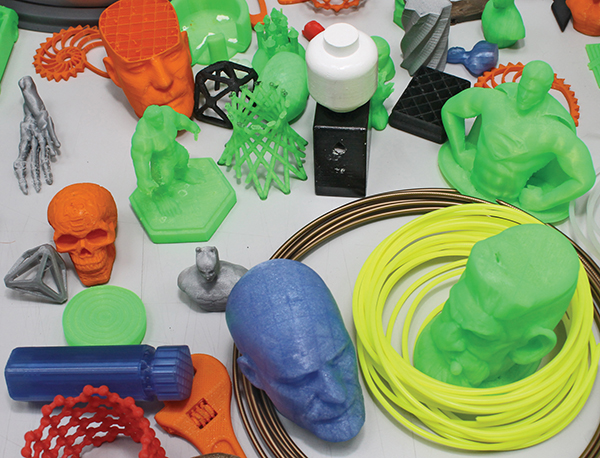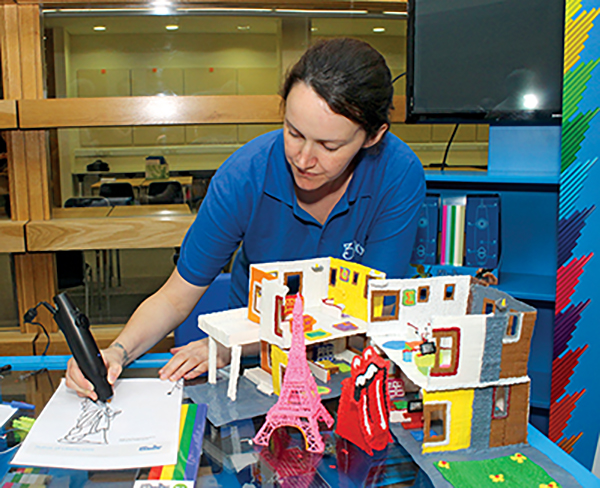
Pictured: Some items produced from 3D printers.
Previously, NewsFour has covered the phenomenon of 3D printing. For those of you who missed it, 3D printers are a range of technologies that produce whole objects, or components of an object, from scratch, either through computer-guided sculpture of raw materials or by ‘printing’ an object layer by layer, again guided by the accuracy of a computer.
Technically, 3D printers are a class of robot, like the factory-installed machines that will have constructed your car. They have been heralded as the next great innovation in manufacturing and home convenience, and many glowing articles have been written in the technology press, promising a near-future where you will be able to print out a can opener or doorstop, rather than buying replacements.
How likely is that, we wondered? NewsFour attended the launch exhibition of University College Dublin’s new U3D facility, to see if there really was a foretaste of the future there.
The exhibition, in the Newstead Building of UCD Belfield campus, was lined with stalls displaying a variety of devices, large and small. The designs were slick; this was a presentation of functioning technology, not an assembly of prototypes.
On entering, a table to the left was littered with elaborate coloured sculptures. These looked like they could only be handmade, but were in fact products of Fused Deposition Modelling, where a fast-setting resin is laid out in layers to gradually form whatever shape has been programmed into the device.
Handling one such model on another table, a six-inch tall model of a woman, you could tell it was the result of a laser-scan of an actual person’s body. Even the variations in shape of her calf muscles had been captured and rendered.
Other technologies on show included an aerial quad-copter drone, which carried a 3D capture camera. Fly it around a hill once and it would be able to show you the exact shape and form of that hill.
Elsewhere, a woman demonstrated the 3Doodler, which looked like a cross between a pen and a tattoo gun, and allowed you to draw shapes, like cubes or models (someone had drawn a Millennium Falcon!). If that sounds a little too miraculous, bear in mind that it takes some skill to draw well on paper, let alone in empty space.
We later spoke with Jonathan Byrne, Centre Manager and expert in 3D modelling and Design Optimisation. He explained that the idea for U3D came about a mere six months before the launch. “We had more and more machines, and the hours to spare, and in truth, 3D printing is at a stage where it’s almost more artistic than a science. We realised the best way to get good with the machines was to do as many diverse projects as possible, so opening up to the public seemed the best way to do that.”
Surprisingly, the technology is older than the recent boom would suggest. “The first stereolithographer was developed in 1984. What’s happened in the last five years is the original patents have expired, and the cost of materials has dropped dramatically.”
Jonathan remains sceptical about the idea of home 3D printing. Some materials are toxic, requiring careful handling, and certain machines, such as the ones which sculpt or etch metals (with a 200 watt laser) are still too experimental and downright expensive to have in the home. Jonathan envisages a future for 3D printing similar to the way people use photocopies. “You might have a home printer that photocopies, and so you do small jobs at home, but if you have an A3 or larger image, or you need to do a larger number of copies, it’s cheaper and easier to go to a place where they specialise and have the right facilities. So my money says it won’t be like a replicator from Star Trek where you can do anything from home. That’s a long way off.”

Pictured: Lisa Deveraux uses the 3Doodler pen.
Discussing whether or not this is a flash-in-the-pan situation, he explained that the cycle will come around again. “In a couple of years, current patents will expire and things will change dramatically, and the quality will improve again.”
See u3d.ie for details and services.
By Rúairí Conneely

